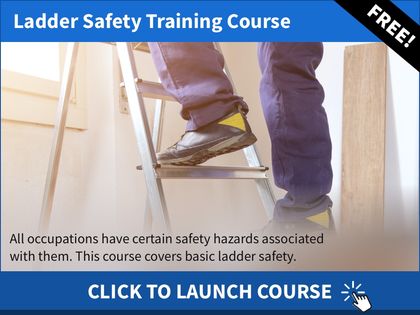How To Create Ladder Safety Training For Employees (And A Free Course!)
Corey Bleich
🍿🍿 8 min. read
In the realm of workplace safety, there's no denying the grim reality: 161 fatal work injuries in 2020 were attributed to ladder-related incidents. It's a chilling reminder of the urgent need for comprehensive fall prevention and ladder safety training.
Whether you're revamping an existing program or starting from scratch, equip your workforce with the skills and confidence to conquer heights while minimizing risks. This post covers how to develop and roll out ladder safety training to your employees. Included, you'll also find a FREE ladder safety training online course that you can immediately roll out to employees who need it most!
Together, let's conquer the heights and make workplace safety an unwavering priority.
🔍 What you’ll find in this post
What is ladder safety training?
As we mentioned, in 2020 there were 161 workplace ladder fatalities. In addition, 22,710 people were injured on ladders at work. The Occupational Safety and Health Administration (OSHA) estimates that the vast majority of these accidents and fatalities could have been prevented with proper training.
Ladder safety training is a critical part of ongoing employee training. As part of OSHA's Safety and Health Regulations for construction, ladder safety training is a requirement. For any work that utilizes an elevated surface that might include a ladder or scaffolding, ladder safety training is generally required. Even if your employees use ladders infrequently, a basic understanding of how to use them properly and safely could just save a life.

Benefits of ladder safety training
Ladder safety training in the workplace is incredibly crucial. These are some of the major benefits:
- Reduced risk of accidents and injuries: Proper ladder safety training significantly lowers the chance of accidents, falls, and workplace injuries.
- Enhanced productivity: Employees trained in ladder safety can work more confidently and efficiently, knowing how to use ladders safely and avoid hazards.
- Regulatory compliance: Implementing ladder safety training ensures compliance with OSHA (as we’ll discuss next) and other safety regulations, minimizing the risk of penalties and legal issues.
- Cost savings: Investing in ladder safety training can lead to savings on medical costs, workers' compensation claims, and lost productivity caused by accidents.
What are OSHA ladder safety training requirements?
The Occupational Safety and Health Administration (OSHA) has ladder safety training requirements that companies must comply with to ensure the safety of their employees. Understanding these requirements is crucial to meet OSHA’s standards.
To start, OSHA mandates that every employee who regularly uses ladders must receive training in their proper use. This requirement applies to employees across various industries and job roles.
OSHA also recognizes that certain work environments require more extensive training. There are specialized training requirements for specific work environments, which may include:
- Scaffolding: Employees working on scaffolding must receive specialized training to ensure safe usage and prevent accidents.
- Ladders near electricity: When employees work with ladders in proximity to electrical hazards, they require additional training to understand the risks and precautions to take.
- Working at heights: Employees engaged in tasks that involve working at significant heights, such as construction workers, roofers, or window cleaners, may require specialized ladder safety training.
- Emergency services: Firefighters, rescue workers, and other emergency response personnel may need specialized training to equip them with the skills to safely and efficiently access elevated areas during emergency situations.
- Outdoor environments: Forestry, agricultural, or adventure tourism employees may require training tailored to the unique challenges of these environments, including rugged terrain, adverse weather conditions, or wildlife encounters.
To comply with OSHA, assess your work environments and job tasks to determine the level of ladder safety training required for employees. Make sure to tailor your training program to address the specific hazards and risks employees may encounter in their roles.
What ladder safety training topics should I cover?
Ladder safety training topics focus specifically on:
- Identifying fall hazards
- Correct procedures for erecting, maintaining, and disassembling fall protection systems
- Maximum load (weight) allowed on different ladders and fall protection systems
- The proper uses of and care for ladders and other equipment
- The use of proper footwear and safety equipment
- General fall prevention training
We also cover some of these in the free ladder safety course below!
👉Discover more: Find our in-depth guide for all the safety topics you should cover in your employee training here.
Identifying fall hazards
This initial aspect of ladder safety training helps employees recognize conditions that might lead to falls. This includes things like worn ladder treads, slick surfaces, and other potential safety issues.
Other fall hazards might include overhanging electrical wires or tree limbs.
Correct procedures for erecting, maintaining, and disassembling fall protection systems
Many falls are caused by equipment that is not set up safely.
Your ladder safety training course should first cover procedures to safely assemble, maintain, and disassemble ladders and other elevated equipment.
Maximum load (weight)
Each ladder and scaffold has a maximum weight that it can hold. This includes both the worker and their tools. Your training should explain how workers can ensure they do not exceed these requirements.
Ladder safety training helps employees identify the different types of ladders and determine which one is suitable for their work and potential load.
Proper use and care
Like every other piece of equipment, ladders require regular maintenance and safety checks.
Basic ladder safety training helps employees recognize the signs of wear that might compromise safety. It also instructs them on ways to alert supervisors to damage or other potential risks.
Ladder safety training helps employees identify the different types of ladders and determine which one is suitable for their work and potential load.
Proper footwear and safety equipment
Even employees who use ladders infrequently must be made aware of the proper footwear and safety equipment required. What seems like a quick trip up a mobile stairway to check a stock number might require a harness or other personal fall arrest system.
Train employees to know what’s required and when, with signage and training.
Fall prevention training
General fall prevention training helps employees develop proper techniques for using equipment to better avoid accidents.
Depending on their role, ladder safety training may cover proper climbing techniques (the three point-of-contact climb) as well as the use of safety harnesses and other fall arrest systems.
How to design ladder safety training for today's employees
Design your ladder safety training by first deciding who needs training and in what order. Employees who regularly use ladders and other elevated work surfaces should be your priority. Use a training needs analysis to quickly figure out your training needs.
👉Discover more: Find our in-depth guide for conducting your training needs analysis.
Find the right training delivery methods
After defining your needs, figure out how you’re going to deliver your training.
Pushing your training online or mobile makes it easy for employees to attend initial training and keep up to date on any changes. A ladder safety training course should be a featured part of your onboarding process, of course, but it’s more than just a one-and-done training.
Like the three point-of-contact climb, consider adding multiple touch-points for training.
Make it easy to remember and hard to forget. Delivering microlearning resources in the flow of work is a great way to keep employees engaged and refreshed on best practices. Consider other training tools to deliver information exactly where it’s needed. For example, you can set up a geofence to alert employees to potential fall hazards in new work areas. A geofence can also deliver a reminder to use personal arrest systems in specific areas.
Roll out performance support
Beyond the initial training, those who work in the field should be able to easily review safety protocols through on-the-job performance support. Performance support tools can also guide employees through proper ladder set-up and removal procedures. Integrate reminders into your employees' days using safety checklists. These ensure compliance at every step of set up, use, and disassembly.
Finally, AR-assisted performance support can be useful for employees who need help using equipment correctly or for managers to quickly put together site-specific resources. Our PinPoint app allows employees to capture 2D images to launch a 3D AR training. This image recognition can be useful at all stages of ladder safety training and support.
Build a culture of safety
To maintain ladder safety practices beyond initial training, it’s important to build a culture of safety. Consider these approaches:
- Regular reinforcement: Keep ladder safety top of mind by providing reminders and refreshers through safety meetings, toolbox talks, or microlearning modules.
- Foster open communication: Encourage employees to report safety concerns and near misses, or suggest improvements to ladder safety protocols, creating a culture where safety is everyone's responsibility.
- Inspect and maintain equipment: Regularly check ladders and related equipment for wear and tear, loose components, and other safety risks.
- Stay updated: Stay informed about the latest ladder safety standards, regulations, and best practices to ensure your training programs reflect current industry knowledge.
By following these tips, your organization can sustain a strong focus on ladder safety, creating a safer work environment and reducing the risk of ladder-related accidents.
Measure ladder safety in the workplace
Once you’ve developed and deployed your ladder safety training at work, assessing its effectiveness is crucial to ensure that employees are equipped with the knowledge and skills to stay safe while working with ladders.
Key metrics to measure include reductions in ladder-related accidents, near misses, and safety violations. Use these methods to evaluate your ladder safety training program:
- Analyze the effectiveness of your training program: This includes assessing the clarity of the training content, the engagement level of employees, and the application of these ladder safety practices.
- Use post-training evaluations: Allow employees to provide feedback on the training's relevance, clarity, and effectiveness. You can also observe employees' behavior in real-life situations to find out how well they apply ladder safety practices.
- Analyze incident reports: This can help determine if the training led to a reduction in ladder-related accidents or near misses.
- Gather feedback surveys: Ask your supervisors and managers about the impact of the training on employee performance and the overall safety culture.
Use these results to refine and enhance your training programs over time, ensuring that they remain effective and relevant. Regular updates to training materials, techniques, and industry best practices can keep your training up-to-date and aligned with evolving safety standards.
Use this free ladder safety training course
Since so many deaths can be prevented with simple training, we developed a free online ladder safety training course that you can use immediately for your employees.
This web-based version only covers the basics and can't take the place of full training, but it's a great place to start if you need to get training out fast. We welcome you to share it with your employees.
Need a more in-depth or industry specific ladder safety training course for your workforce? EdgePoint Learning can help. We create full custom online training courses, or act as an extension of your team with co-development options.
Plus, PinPoint is our precision microlearning app that helps your employees access mobile training right in the flow of work, with robust performance support tools. Check out PinPoint’s pre-built content library or get in touch to learn more!
From custom to co-development, online learning to a blended approach, we can help.


